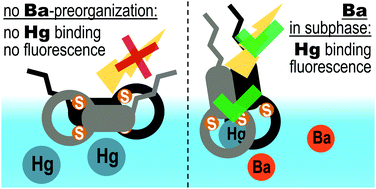Supramolecular control of the structure and receptor properties of an amphiphilic hemicyanine chromoionophore monolayer at the air/water interface†
Abstract
Designing sensors for toxic compounds such as mercury salts in aqueous solutions still remains one of the most pressing tasks of modern chemical research, since many existing systems do not show enough sensitivity and/or response. In this regard, the opportunities offered by supramolecular approaches can be used to improve both these characteristics by creating a new self-organized smart system. Herein, we show that barium cations, that according to the data of X-ray standing waves do not bind directly to the ionophore molecules in the monolayers at the air/water interface, could be used to efficiently preorganize such molecules to achieve supramolecular architecture. We demonstrate that such preorganization ensures both low analyte detection threshold and high fluorescent response. We reveal the interrelation of the monolayer structure and receptor characteristics of a sensory system and show that such cation-induced preorganization in Langmuir monolayers of a hemicyanine dithia-aza-crown-substituted chromoionophore inhibits the formation of non-fluorescent aggregates with low receptor function, and allows the quantitative detection of mercury cations using a ratiometric fluorometric approach.



 Please wait while we load your content...
Please wait while we load your content...